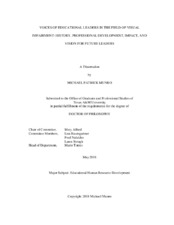| dc.contributor.advisor | Alfred, Mary | |
| dc.creator | Munro, Michael Patrick | |
| dc.date.accessioned | 2019-01-17T18:09:06Z | |
| dc.date.available | 2020-05-01T06:23:10Z | |
| dc.date.created | 2018-05 | |
| dc.date.issued | 2018-04-30 | |
| dc.date.submitted | May 2018 | |
| dc.identifier.uri | https://hdl.handle.net/1969.1/173469 | |
| dc.description.abstract | This study documented the career development and contributions of 11 established leaders in the field of visual impairment who hold or have held influential positions across the state of Texas in the period 1995-2018. This investigation used Hanson’s Integrative Life Planning, Schosseburg’s Transition theory, and several adult learning theories as a base for the investigation. Each participant was selected for interview from a pool of leaders identified by award from the state professional organization and who responded to an initial survey about the phenomenon of moving from practitioner to leader in the field.
Profiles of the leaders were developed through collected vitae. Bridling was used as a means of controlling bias and an epoché of the author was developed. Interviews were transcribed, coded, and separated using the phenomenological techniques of horizontalization. Analysis led to the development of meaning clusters both in and between narratives. These clusters were then developed into themes. The study discusses themes around entry into the field, highlights the advancements witnessed and fostered by the leaders, details their hopes and fears for the future, and collects thoughts on the future of leadership in the field. All the leaders showed an incredible passion for and commitment to the field of visual impairment. This was in spite of the fact that most had discovered the field accidentally. Uniformly these leaders felt not enough was being done to develop future leaders. With the identified shortage of trained personnel and the impending departure of many leaders in the field, the collection of this data was both a means of developing a field history for this period and of transferring knowledge of these leaders to the next generation.
The field is one built on unity of purpose and has had its focus on improving lives of the population served. Advocacy and leadership skills need to be developed across the field as a means of improving these individual lives. However, to maintain current standards and to aid continued improvement, more needs to be done in regards to succession planning and training professionals in what it takes to transition to leadership. | en |
| dc.format.mimetype | application/pdf | |
| dc.language.iso | en | |
| dc.subject | Leadership | en |
| dc.subject | Visual Impairment | en |
| dc.title | Voices of Educational Leaders in the Field of Visual Impairment: History, Professional Development, Impact, and Vision for Future Leaders | en |
| dc.type | Thesis | en |
| thesis.degree.department | Educational Administration and Human Resource Development | en |
| thesis.degree.discipline | Educational Human Resource Development | en |
| thesis.degree.grantor | Texas A & M University | en |
| thesis.degree.name | Doctor of Philosophy | en |
| thesis.degree.level | Doctoral | en |
| dc.contributor.committeeMember | Baumgartner, Lisa M | |
| dc.contributor.committeeMember | Nafukho, Fredrick M | |
| dc.contributor.committeeMember | Stough, Laura M | |
| dc.type.material | text | en |
| dc.date.updated | 2019-01-17T18:09:06Z | |
| local.embargo.terms | 2020-05-01 | |
| local.etdauthor.orcid | 0000-0003-0986-9418 | |


